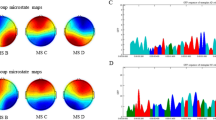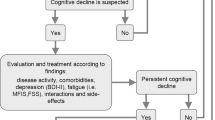Abstract
Background and purpose
Limited studies had jointly excavated the structural and functional changes in cognitive deficit in anti-N-methyl-D-aspartate receptor (NMDAR) encephalitis patients. We aimed to explore these changes in anti-NMDAR patients and their effect on cognitive function.
Methods
Twenty-three patients and 25 healthy controls (HCs) underwent resting-state functional magnetic resonance imaging, diffusion tensor imaging scanning, and neuroethology tests. The significantly differentiated brain regions via the fractional amplitude of low-frequency fluctuation (fALFF) were defined as regions of interest (ROIs). Granger causal, functional connectivity, and tract-based spatial statistical analyses were applied to explore the functional changes in ROIs and assess the structural changes.
Results
HCs outperformed patients in Montreal Cognitive Assessment. The fALFF values of right gyrus rectus (RGR) in patients were significantly reduced. The fractional anisotropy (FA) values of WM in the genu of corpus callosum and right superior corona radiata were significantly decreased and positively associated with neuroethology testing scores. The Granger causal connectivity (GCC) from the left inferior parietal lobule to RGR was significantly decreased and positively associated with inherent vigilance. Indicated by the multiple linear regression result, decreased FA value of the right superior corona radiata might be a reliable marker that reflects the cognitive impairment.
Conclusions
Significant changes in spontaneous neural activities, GCC, and WM structures in anti-NMDAR encephalitis were reported. These findings promote the understanding of underlying relationships between cerebral function, structural network alterations, and cognitive dysfunction.




Similar content being viewed by others
Data availability
Available upon request.
References
Graus F, Titulaer MJ, Balu R et al (2016) A clinical approach to diagnosis of autoimmune encephalitis. Lancet Neurol 15(4):391–404. https://doi.org/10.1016/S1474-4422(15)00401-9
Nosadini M, Eyre M, Molteni E et al (2021) Use and safety of immunotherapeutic management of N-methyl-d-aspartate receptor antibody encephalitis: a meta-analysis. JAMA Neurol 78(11):1333–1344. https://doi.org/10.1001/jamaneurol.2021.3188
Venkatesan A, Michael BD, Probasco JC, Geocadin RG, Solomon T (2019) Acute encephalitis in immunocompetent adults. Lancet 393(10172):702–716. https://doi.org/10.1016/S0140-6736(18)32526-1
Bacchi S, Franke K, Wewegama D, Needham E, Patel S, Menon D (2018) Magnetic resonance imaging and positron emission tomography in anti-NMDA receptor encephalitis: a systematic review. J Clin Neurosci 52:54–59. https://doi.org/10.1016/j.jocn.2018.03.026
Liang Y, Cai L, Zhou X, Huang H, Zheng J (2020) Voxel-based analysis and multivariate pattern analysis of diffusion tensor imaging study in anti-NMDA receptor encephalitis. Neuroradiology 62(2):231–239. https://doi.org/10.1007/s00234-019-02321-x
Gibson LL, McKeever A, Coutinho E, Finke C, Pollak TA (2020) Cognitive impact of neuronal antibodies: encephalitis and beyond. Transl Psychiatry 10(1):304. https://doi.org/10.1038/s41398-020-00989-x
Peer M, Pruss H, Ben-Dayan I, Paul F, Arzy S, Finke C (2017) Functional connectivity of large-scale brain networks in patients with anti-NMDA receptor encephalitis: an observational study. Lancet Psychiatry 4(10):768–774. https://doi.org/10.1016/S2215-0366(17)30330-9
Noroozi A, Rezghi M (2020) A tensor-based framework for rs-fMRI classification and functional connectivity construction. Front Neuroinform 14:581897. https://doi.org/10.3389/fninf.2020.581897
Hao L, Sheng Z, Ruijun W, Kun HZ, Peng Z, Yu H (2020) Altered Granger causality connectivity within motor-related regions of patients with Parkinson’s disease: a resting-state fMRI study. Neuroradiology 62:63–69. https://doi.org/10.1007/s00234-019-02311-z
Li C, Pang X, Shi K, Long Q, Liu J, Zheng J (2021) The insula is a hub for functional brain network in patients with anti-n-methyl-d-aspartate receptor encephalitis. Front Neurosci 15:642390. https://doi.org/10.3389/fnins.2021.642390
Cai L, Liang Y, Huang H, Zhou X, Zheng J (2020) Cerebral functional activity and connectivity changes in anti-N-methyl-D-aspartate receptor encephalitis: a resting-state fMRI study. Neuroimage Clin 25:102189. https://doi.org/10.1016/j.nicl.2020.102189
Finke C, Kopp UA, Scheel M et al (2013) Functional and structural brain changes in anti-N-methyl-D-aspartate receptor encephalitis. Ann Neurol 74(2):284–296. https://doi.org/10.1002/ana.23932
Fan J, Gu X, Guise KG et al (2009) Testing the behavioral interaction and integration of attentional networks. Brain Cogn 70(2):209–220. https://doi.org/10.1016/j.bandc.2009.02.002
Zou QH, Zhu CZ, Yang Y et al (2008) An improved approach to detection of amplitude of low-frequency fluctuation (ALFF) for resting-state fMRI: fractional ALFF. J Neurosci Method 172(1):137–141. https://doi.org/10.1016/j.jneumeth.2008.04.012
Xia M, Wang J, He Y (2013) BrainNet Viewer: a network visualization tool for human brain connectomics. PLoS One 8(7):e68910. https://doi.org/10.1371/journal.pone.0068910
Cui Z, Zhong S, Xu P, He Y, Gong G (2013) PANDA: a pipeline toolbox for analyzing brain diffusion images. Front Hum Neurosci 7:42. https://doi.org/10.3389/fnhum.2013.00042
Sakurai T, Gamo NJ (2019) Cognitive functions associated with developing prefrontal cortex during adolescence and developmental neuropsychiatric disorders. Neurobiol Dis 131:104322. https://doi.org/10.1016/j.nbd.2018.11.007
Dalmau J (2016) NMDA receptor encephalitis and other antibody-mediated disorders of the synapse: the 2016 Cotzias Lecture. Neurology 87(23):2471–2482. https://doi.org/10.1212/WNL.0000000000003414
Breukelaar IA, Antees C, Grieve SM et al (2017) Cognitive control network anatomy correlates with neurocognitive behavior: a longitudinal study. Hum Brain Mapp 38(2):631–643. https://doi.org/10.1002/hbm.23401
Bi XA, Xu Q, Luo X, Sun Q, Wang Z (2018) Weighted random support vector machine clusters analysis of resting-state fMRI in mild cognitive impairment. Front Psychiatry 9:340. https://doi.org/10.3389/fpsyt.2018.00340
Qiu A, Mori S, Miller MI (2015) Diffusion tensor imaging for understanding brain development in early life. Annu Rev Psychol 66:853–876. https://doi.org/10.1146/annurev-psych-010814-015340
Gao S, Ming Y, Wang J et al (2020) Enhanced prefrontal regional homogeneity and its correlations with cognitive dysfunction/psychopathology in patients with first-diagnosed and drug-naive schizophrenia. Front Psychiatry 11:580570. https://doi.org/10.3389/fpsyt.2020.580570
Dalmau J, Armangue T, Planaguma J et al (2019) An update on anti-NMDA receptor encephalitis for neurologists and psychiatrists: mechanisms and models. Lancet Neurol 18(11):1045–1057. https://doi.org/10.1016/S1474-4422(19)30244-3
Tong J, Zhou Y, Huang J et al (2021) N-methyl-D-aspartate receptor antibody and white matter deficits in schizophrenia treatment-resistance. Schizophr Bull 47(5):1463–1472. https://doi.org/10.1093/schbul/sbab003
Phillips OR, Joshi SH, Narr KL et al (2018) Superficial white matter damage in anti-NMDA receptor encephalitis. J Neurol Neurosurg Psychiatry 89(5):518–525. https://doi.org/10.1136/jnnp-2017-316822
Qiao J, Zhao X, Wang S et al (2020) Functional and structural brain alterations in encephalitis with LGI1 antibodies. Front Neurosci 14:304. https://doi.org/10.3389/fnins.2020.00304
Cui Y, Dong J, Yang Y et al (2020) White matter microstructural differences across major depressive disorder, bipolar disorder and schizophrenia: a tract-based spatial statistics study. J Affect Disord 260:281–286. https://doi.org/10.1016/j.jad.2019.09.029
Ruotsalainen I, Gorbach T, Perkola J et al (2020) Physical activity, aerobic fitness, and brain white matter: their role for executive functions in adolescence. Dev Cogn Neurosci 42:100765. https://doi.org/10.1016/j.dcn.2020.100765
Fields RD (2008) White matter in learning, cognition and psychiatric disorders. Trends Neurosci 31(7):361–370. https://doi.org/10.1016/j.tins.2008.04.001
Bells S, Lefebvre J, Prescott SA et al (2017) Changes in white matter microstructure impact cognition by disrupting the ability of neural assemblies to synchronize. J Neurosci 37(34):8227–8238. https://doi.org/10.1523/JNEUROSCI.0560-17.2017
Pruss H, Holtje M, Maier N et al (2012) IgA NMDA receptor antibodies are markers of synaptic immunity in slow cognitive impairment. Neurology 78(22):1743–1753. https://doi.org/10.1212/WNL.0b013e318258300d
Caspers S, Schleicher A, Bacha-Trams M, Palomero-Gallagher N, Amunts K, Zilles K (2013) Organization of the human inferior parietal lobule based on receptor architectonics. Cereb Cortex 23(3):615–628. https://doi.org/10.1093/cercor/bhs048
Wu P, Pang X, Liang X et al (2022) Correlation analysis between regional homogeneity and executive dysfunction in anti-N-methyl-D-aspartate receptor encephalitis patients. Eur J Neurol 29(1):277–285. https://doi.org/10.1111/ene.15119
Barbeau EB, Chai XJ, Chen JK et al (2017) The role of the left inferior parietal lobule in second language learning: an intensive language training fMRI study. Neuropsychologia 98:169–176. https://doi.org/10.1016/j.neuropsychologia.2016.10.003
Acknowledgements
We are sincerely grateful to all the participants. Moreover, we are very grateful to Wei Ye, the radiology technician, for his help and support in the MRI data acquisition.
Funding
This study was supported by the grant from the National Natural Science Foundation of China (Number: 81560223).
Author information
Authors and Affiliations
Contributions
Minda Wei: study design, analyzing the data, writing original manuscript. Zexiang Chen: methodology and statistical analysis. Caitiao Lv and Weining Cen: investigation and data acquisition. Jinou Zheng: providing funding, study design, and revision of the manuscript. All the authors contributed to this research and read and approved the final manuscript.
Corresponding author
Ethics declarations
Ethics approval
The protocol was approved by the First Affiliated Hospital of Guangxi Medical University Ethics Committee.
Consent to participate
All the subjects (or kinsfolk) signed a written informed consent about the study.
Competing interest
The authors declare no competing interests.
Additional information
Publisher's note
Springer Nature remains neutral with regard to jurisdictional claims in published maps and institutional affiliations.
Supplementary Information
Below is the link to the electronic supplementary material.
Rights and permissions
Springer Nature or its licensor (e.g. a society or other partner) holds exclusive rights to this article under a publishing agreement with the author(s) or other rightsholder(s); author self-archiving of the accepted manuscript version of this article is solely governed by the terms of such publishing agreement and applicable law.
About this article
Cite this article
Wei, M., Chen, Z., Lv, C. et al. The alterations of spontaneous neural activities and white matter microstructures in anti-N-methyl-D-aspartate receptor encephalitis: a resting-state fMRI and DTI study. Neurol Sci 44, 1341–1350 (2023). https://doi.org/10.1007/s10072-022-06574-y
Received:
Accepted:
Published:
Issue Date:
DOI: https://doi.org/10.1007/s10072-022-06574-y




